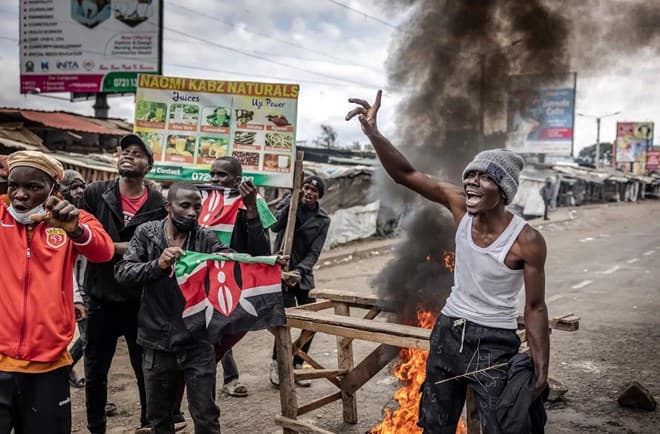We're loading the full news article for you. This includes the article content, images, author information, and related articles.
Whether the country moves toward greater constitutional fidelity or deeper confrontation may well define the next phase of Kenya’s democratic project.

As political unrest simmers across Kenya following weeks of youth-led protests and opposition-backed boycotts, tensions between county governments and the national executive are flaring into open conflict. From budgetary standoffs to accusations of undermined devolved functions, the fragile balance between the two levels of government—enshrined in the 2010 Constitution—is once again under intense strain.
Recent developments suggest that the wave of demonstrations has not only exposed citizen discontent but also reignited long-standing rivalries over revenue allocation, policing, and administrative autonomy. As counties seek to assert their constitutional authority, the national government appears increasingly inclined toward central control—setting the stage for a potential governance crisis.
Several counties, particularly in opposition strongholds like Kisumu, Mombasa, and Nairobi, have clashed openly with the national government over their handling of protests. Governors have accused the Interior Ministry of deploying security forces without consultation and engaging in “militarized crowd control” that undermines civilian leadership.
“We were not consulted, yet tear gas was fired on hospital grounds and market areas under county jurisdiction,” said Kisumu Governor Prof. Anyang’ Nyong’o during a press conference last week. “This is not law enforcement; it is state intimidation.”
In Nairobi, Governor Johnson Sakaja has been caught between loyalty to the ruling coalition and mounting public pressure. His silence during the July 7 Saba Saba commemorations, which turned deadly, was interpreted by many as complicity with national-level crackdowns.
Meanwhile, in counties like Kericho and Embu, allied with the Kenya Kwanza administration, local leaders have accused the Treasury of delaying disbursements—despite growing service delivery obligations in volatile times. “Counties are being strangled financially,” said a senior county finance executive, who requested anonymity due to political sensitivities.
Kenya’s 2010 Constitution ushered in devolution as a mechanism to decentralize power, reduce ethnic marginalization, and bring services closer to the people. But 12 years on, the national government still controls key levers—especially policing, tax collection, and emergency response—often using these tools to assert dominance over counties.
According to Article 6 and the Fourth Schedule, functions such as health, agriculture, and urban planning are fully devolved. Yet, governors routinely report being sidelined on major policy decisions and resource allocation.
“Devolution is not charity—it is a constitutional right,” said Council of Governors Chairperson Anne Waiguru in a recent statement. “What we are seeing is an erosion of that promise, especially during times of crisis.”
Experts argue that the unrest has laid bare the incomplete devolution process. “The national government has never fully let go of control,” said constitutional lawyer Wachira Maina. “In times of political tension, the instinct is to centralize, but that runs contrary to the spirit of devolution.”
Perhaps the most contentious issue is security. While national law enforcement falls under the purview of the National Police Service, counties are expected to manage public amenities and local disaster response. During recent protests, multiple governors complained they were neither briefed nor given a chance to coordinate with local police.
In Kisii, chaos erupted when security forces fired live rounds during a peaceful demonstration near the county assembly. Governor Simba Arati later claimed he had no prior knowledge of the operation. “How do we account for civilian deaths when we are excluded from the chain of command?”
This dynamic has prompted calls to revisit the National Police Service Act and consider devolving elements of community policing to county governments—a proposal the executive has long resisted.
The political unrest has also exacerbated disputes over the equitable share of national revenue. As counties grapple with rising food insecurity, health crises, and infrastructure backlogs, delayed disbursements and contested allocations from the National Treasury have fueled resentment.
The Council of Governors has accused the national government of weaponizing cash flow to control county narratives—especially those perceived to be critical of state policy. In a fiery session before the Senate Finance Committee, several governors decried “deliberate underfunding” and “political budgeting.”
Efforts to push for increased allocations under the County Governments Additional Allocations Bill have stalled amid accusations that the executive is cherry-picking which counties receive funding on time.
Analysts warn that the continued marginalization of county voices risks eroding public trust—not just in the presidency but in the broader constitutional order. For many Kenyans, particularly the youth, county governments represent the closest link to responsive governance.
“If counties are weakened and the center is seen as unaccountable, it creates a legitimacy vacuum,” says Dr. Linda Musumba, a governance lecturer at Kenyatta University. “That’s a dangerous space, especially when combined with youth frustration and economic desperation.”
With calls for national dialogue growing louder—from religious leaders, civil society, and business groups—the spotlight is increasingly on how the national and county governments will recalibrate their relationship. Whether the country moves toward greater constitutional fidelity or deeper confrontation may well define the next phase of Kenya’s democratic project.
What is clear, however, is that the promise of devolution will remain unfulfilled unless both levels of government engage in genuine power-sharing, especially in moments of crisis. For now, the unrest has not only tested Kenya’s streets—it is testing the very foundations of its governance model.
Keep the conversation in one place—threads here stay linked to the story and in the forums.
Other hot threads
E-sports and Gaming Community in Kenya
Active 7 months ago
Popular Recreational Activities Across Counties
Active 7 months ago
The Role of Technology in Modern Agriculture (AgriTech)
Active 7 months ago
Investing in Youth Sports Development Programs
Active 7 months ago